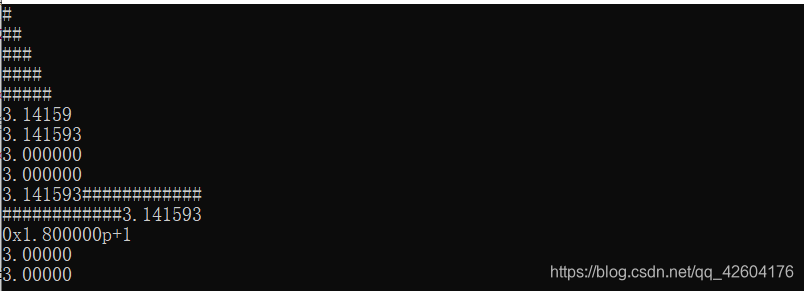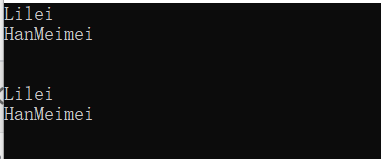目錄
- 1、格式化輸出
- 1. setw manipulator(“設置域寬”控制符)
- 2. setprecision manipulator(“設置浮點精度”控制符)
- 3. setfill manipulator(“設置填充字符”控制符)
- 4. Formatting Output in File Operation(在文件操作中格式化輸入/輸出)
- 5.小練習
- 2、用于輸入/輸出流的函數
- 1. getline()
- 2. get() and put()
- 3. flush()
- 4.getline()練習
1、格式化輸出
1. setw manipulator(“設置域寬”控制符)
要包含頭文件
setw(n) 設置域寬,即數據所占的總字符數
std::cout << std::setw(3) << 'a' << std::endl;
輸出:
_ _a
setw()控制符只對其后輸出的第一個數據有效
std::cout << std::setw(5) << 'a'<< 'b' << std::endl;
輸出:
_ _ _ _ab
setw()的默認為setw(0),按實際輸出。
如果輸出的數值占用的寬度超過setw(int n)設置的寬度,則按實際寬度輸出。
float f=0.12345;std::cout << std::setw(3) << f << std::endl;
輸出:
0.12345
2. setprecision manipulator(“設置浮點精度”控制符)
setprecision(int n)
(1) 控制顯示浮點數的有效位
(2) n代表數字,總位數,不包括小數點
#include <iostream>
#include <iomanip>
using namespace std;int main() {float f = 17 / 7.0;cout << f << endl;cout << setprecision(0) << f << endl;cout << setprecision(1) << f << endl;cout << setprecision(2) << f << endl;cout << setprecision(3) << f << endl;cout << setprecision(6) << f << endl;cout << setprecision(8) << f << endl;return 0;}
VS效果:
2.42857
2.42857
2
2.4
2.43
2.42857
2.4285715
3. setfill manipulator(“設置填充字符”控制符)
setfill?
設置填充字符,即“<<"符號后面的數據長度小于域寬時,使用什么字符進行填充。
std::cout << std::setfill('*') << std::setw(5) << 'a' << std::endl;
輸出:
****a
4. Formatting Output in File Operation(在文件操作中格式化輸入/輸出)

5.小練習
本部分展示內容如下;
任務1:展示setw和setfill
1、setw只對緊跟隨其后的數據起作用
2、setfill指定填充字符
任務2:展示setprecision、fixed、showpoint、left、right
任務3:展示hexfloat
#include <iostream>
#include <iomanip>using std::cout;
using std::endl;
int main()
{//任務1:展示setw和setfill//cout << std::setw(4) << std::setfill('#') << "a";cout << std::setfill('#');for (int i = 0;i < 5;i++){cout << std::setw(i+2) << ' ' << endl;}//任務2:展示setprecision、fixed、showpoint、left、rightdouble pi = 3.1415926535897;cout << std::setprecision(6) << pi << endl;//定點數代表了小數點后幾位cout << std::setprecision(6) << std::fixed << pi << endl;double y = 3.0;cout << y << endl;cout << std::showpoint << y << endl;cout << std::setw(20) << std::left << pi << endl;cout << std::setw(20) << std::right << pi << endl;//任務3:展示hexfloatcout << std::hexfloat << y << endl;cout << std::defaultfloat;cout << y << endl;cout << std::showpoint << y << endl;return 0;
}

2、用于輸入/輸出流的函數
1. getline()
'>>'運算符用空格分隔數據
對于文件內容:
Li Lei#Han Meimei#Adam
如下代碼只能讀入“Li”
ifstream input("name.txt");
std::string name;
input >> name;
如果用成員函數getline(char* buf, int size, char delimiter)讀LiLei:
constexpr int SIZE{ 40 };
std::array<char , SIZE> name{};
while (!input.eof()) {// not end of fileinput.getline(&name[ 0 ] , SIZE , '#');std::cout << &name[ 0 ] << std::endl;
}
如果用非成員函數getline(istream& is, string& str, char delimiter)讀LiLei:
std::string name2{};
while (!input.eof()) {std::getline(input, name2, '#');std::cout << n << std::endl;
}
2. get() and put()
get: read a character
//這一種需要將int類型強制轉換為char類型
//char c = static_cast<char>(in.get());
int istream::get();
//char c; in.get(c);
istream& get (char& c);
put write a character
ostream& put (char c);
3. flush()
將輸出流緩存中的數據寫入目標文件:
ostream& flush();
用法:
cout.flush(); // 其它輸出流對象也可以調用 flush()
cout << "Hello" << std::flush; // 與endl類似作為manipulator的調用方式
4.getline()練習
本部分要展示的內容如下;
任務1:展示istream::getline函數的用法
任務2:展示std::getline函數的用法
#include <iostream>
#include <fstream>
#include <array>
#include <string>
#include <filesystem>
using std::cout;
using std::endl;
using std::ifstream;
using std::string;int main()
{//打開文件std::filesystem::path p{ "scores.txt" };ifstream in{p};if (!in){cout << "Can't open file" << p << endl;std::abort();}//任務1:istream::getline函數constexpr int SIZE = 1024;std::array<char, SIZE> buf; //&bufwhile (!in.eof()){in.getline(&buf[0], SIZE, '#');cout << &buf[0] << endl;}//由于上面的操作已經讀到文件末尾,此時需要關閉重新打開文件in.close();in.open(p);//任務2:std::getline函數的用法std::string name1{""};while (!in.eof()){std::getline(in,name1,'#');cout << name1 << endl;}std::cin.get();return 0;}
效果:

默認情況下,getline函數使用換行符作為分隔符

)












)




